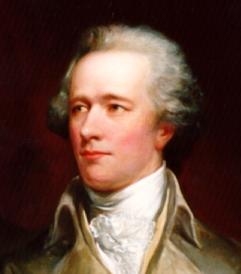This is an old revision of this page, as edited by JillandJack (talk | contribs) at 16:35, 18 March 2004. The present address (URL) is a permanent link to this revision, which may differ significantly from the current revision.
Revision as of 16:35, 18 March 2004 by JillandJack (talk | contribs)(diff) ← Previous revision | Latest revision (diff) | Newer revision → (diff)
Maj. Gen. Alexander Hamilton
Secretary of the Treasury of the United States
Alexander Hamilton was born on the West Indies Island of Nevis on January 11, 1757. He went to New York in 1772 for his formal education, beginning with grammar school. Later he attended King's College, which is now Columbia University.
Hamilton's great genius revealed itself early. While in his teens, he took a firm stand on the side of the patriots, and became a leader in the movement advocating independence. Before he was 20 years of age, Hamilton commanded artillery troops in several important battles, and from 1777 to 1781, served as aide-de-camp to General Washington.
He left Washington to take command of an infantry regiment that took part in the siege of Yorktown. At the age of 25, he served as a member of the Continental Congress from 1782-1783, then retired to open his own law office in New York City. His public career continued when he attended the Annapolis Convention as a delegate in 1786.
He also served in the New York State Legislature and attended the Philadelphia Convention in 1787. Throughout the convention's proceedings Hamilton, who was a federalist, argued consistently for a strong central government, including an upper house with members appointed for life rather than subject to re-election. Although the document finally produced by the convention was less centralist than Hamilton proposed, he was active in the successful campaign for its ratification as the Constitution of the United States on September 2, 1789. In this endeavour Hamilton made the largest single contribution to the authorship of the Federalist Papers.
Hamilton served another term in 1788 in what proved to be the last time the Continental Congress met under the new Articles of Confederation.
President George Washington appointed him to be the first Secretary of the Treasury when the first Congress passed an Act establishing the Treasury Department. He served as Secretary of the Treasury from September 11, 1789 until January 31, 1795.
As Secretary of the Treasury, Hamilton's term was marked by bold innovation, statesmanlike planning, and masterful reports. His financial program provided public credit where there was none before, and gave the infant Nation a circulating medium and financial machinery.
After being in office for barely one month, he proposed the idea of a seagoing branch of the military to secure the revenue against contraband. The following summer, the Congress authorized a Revenue Marine force of ten cutters. The Revenue Marine is now the United States Coast Guard. He also played a crucial role in creating the United States Navy (the Naval Act of 1794). Hamilton also proposed the creation of a Naval Academy, an idea ahead of his time.
He published Report on the Public Credit on January 14, 1790, (although some reports put the date at January 9, 1790), which amounted to a watershed in American history, marking the end of an era of bankruptcy and repudiation. The plan provided for assumption of both the domestic and the foreign debts. Both James Madison and Thomas Jefferson strongly opposed Hamilton's plan, but it passed overwhelmingly. He advocated assumption by the Federal Government of the debts of the States. Madison and Jefferson also opposed this plan, but they settled the contest in a private meeting on July 21, 1790. During this meeting, Hamilton agreed to the future location of the Nation's Capital on the Potomac River, in return for Jefferson's support of assumption.
Hamilton's perceptive and creative mind coupled with his driving ambition to set his ideas in motion resulted many proposals to the Congress. His proposals included a plan including import duties and excise taxes for raising revenue, funding of the revolutionary debt, and suggestions on naval laws. He also developed plans for a Congressional charter for the First Bank of the United States, and for placing the revenues on firm ground.
Strong opposition to collection efforts of his excise tax on spirits erupted into the Whiskey Rebellion in Western Pennsylvania and Virginia in 1794. Hamilton felt that compliance with the laws was very urgent. He accompanied General "Light Horse Harry" Lee and his troops part of the way in an advisory capacity to help put down the insurrection.
Hamilton's resignation as Secretary of the Treasury in 1795 did not remove him from public life. With the resumption of his law practice, he remained close to Washington as an advisor and friend and he is believed to have influenced Washington in the latter's composition of his Farewell Address. Relations between Hamilton and Washington's successor, John Adams, were frequently strained and Hamilton's attempts to frustrate Adams' adoption as presidential candidate of the Federalist Party split the party and contributed to the victory of the Jeffersonian Republicans in the election of 1800.
Hamilton's role in ensuring the subsequent selection of Jefferson as President in preference to Aaron Burr was one of a number of factors arousing Burr's anger, prompting him to fight a duel with Hamilton on July 11, 1804. Hamilton was shot in the duel. The bullet entered Hamilton below the chest and was fatal. He died the following day and was interred in the Trinity Churchyard Cemetery in Manhattan, New York.
Hamilton's portrait appears on the U.S. $10 bill. USS Alexander Hamilton was named in his honor.